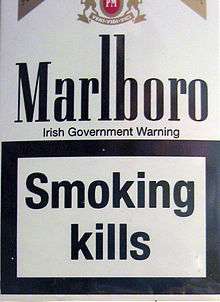Warning label
A warning label is a label attached to a product, or contained in a product's instruction manual, warning the user about risks associated with its use, and may include restrictions by the manufacturer or seller on certain uses.[1] Most of them are placed to limit civil liability in lawsuits against the item's manufacturer or seller (see product liability).[2][3] That sometimes results in labels which for some people seem to state the obvious.



Government regulation
In the United States warning labels were instituted under the Federal Food, Drug, and Cosmetic Act of 1938.[4] Cigarettes were not required to have warning labels in the United States until in 1965 Congress passed the Federal Cigarette Labeling and Advertising Act (FCLAA).[5]
In the EEA, a product containing hazardous mixtures must have a Unique formula identifier (UFI) code. This is not a warning label per sé, but a code that helps poison control centres identify the exact formula of the hazardous product.
Abnormal warning labels
Warning labels have been produced for different items. In some cases, rumors have developed of labels warning against some very strange occurrences, such as the legendary microwave warning that allegedly states 'do not dry pets in microwave'.[6]
Some companies hold 'strange warning label competitions' such as the former M-law[7][8] wacky warning labels competition.[9]
While many safe products intended for human consumption may require warning labels due to the health risks associated with using them, it is only tobacco products that have strongly worded warnings on their health risks.
See also
- Alcohol packaging warning messages
- California Proposition 65 (1986)
- Tobacco packaging warning messages
- Warning Labels for Soft Drinks
- History of warning labels in the US
References
- Wogalter, Michael S. (2006). "Introduction". In Wogalter, Michael S. (ed.). Handbook of warnings. Mahwah, New Jesey: Lawrence Erlbaum Associates. ISBN 978-0-8058-4724-6.
- Egilman, D. & Bohme, S. R. (2006). "Purposes and Scope of Warnings". In Wogalter, Michael S. (ed.). Handbook of warnings. Mahwah, New Jesey: Lawrence Erlbaum Associates. ISBN 978-0-8058-4724-6.
- Khoury, Clarke E. (1989). "Warning Labels May Be Hazardous to Your Health: Common-Law and Statutory Responses to Alcoholic Beverage Manufacturers' Duty to Warn". Cornell Law Review. 75: 158–188.
- Federal Food, Drug, & Cosmetic Act, Pub. L. No. 75-717, 52 Stat. 1040 (1938) (codified as amended at 21 U.S.C. §§ 301-99 (2006))
- Federal Cigarette Labeling and Advertising Act, Pub. L. No. 89-92, 79 Stat. 282 (1965) (codified as amended at 15 U.S.C. §§ 1331-40 (1970)).
- "The Microwaved Pet". Snopes.
- "M-Law Announces Winners Of Seventh Annual Wacky Warning Label Contest". 2004. Archived from the original on 9 June 2004.
- ""Danger: Avoid Death" Warning Wins Top Prize In M-Law's Eleventh Annual Wacky Warning Label Contest". 2011. Archived from the original on 24 April 2013.
- Nelson, Brett & Finneran, Katy (23 February 2011). "Dumbest Warning Labels". Forbes. Archived from the original on 25 February 2011.
External links